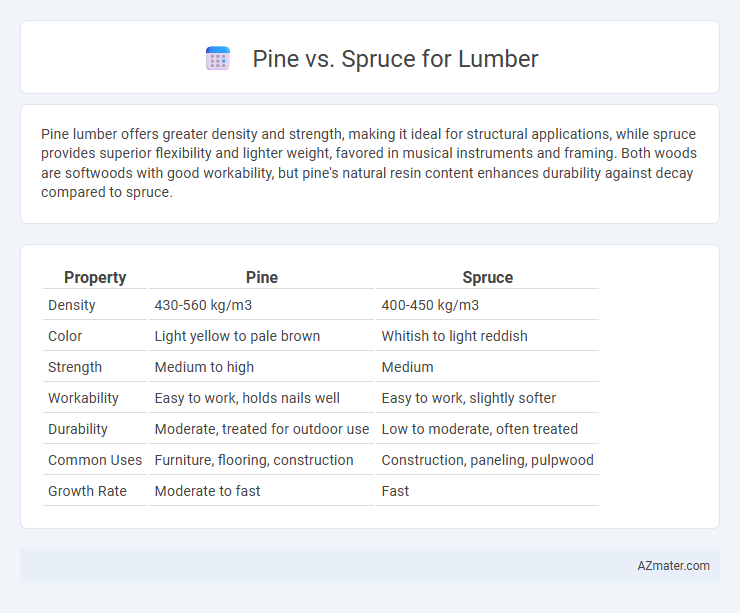Pine lumber offers greater density and strength, making it ideal for structural applications, while spruce provides superior flexibility and lighter weight, favored in musical instruments and framing. Both woods are softwoods with good workability, but pine's natural resin content enhances durability against decay compared to spruce.
Table of Comparison
| Property | Pine | Spruce |
|---|---|---|
| Density | 430-560 kg/m3 | 400-450 kg/m3 |
| Color | Light yellow to pale brown | Whitish to light reddish |
| Strength | Medium to high | Medium |
| Workability | Easy to work, holds nails well | Easy to work, slightly softer |
| Durability | Moderate, treated for outdoor use | Low to moderate, often treated |
| Common Uses | Furniture, flooring, construction | Construction, paneling, pulpwood |
| Growth Rate | Moderate to fast | Fast |
Introduction: Pine vs Spruce Lumber
Pine and spruce are two of the most commonly used softwoods in lumber production, each offering distinct characteristics suited for various construction and woodworking projects. Pine lumber is known for its relatively higher resin content, straight grain, and ease of staining, making it ideal for furniture and interior finishes. Spruce lumber, on the other hand, features a lighter color with fine, uniform texture and is often favored for structural applications due to its strength-to-weight ratio and dimensional stability.
Botanical Differences Between Pine and Spruce
Pine trees belong to the genus Pinus, characterized by long needles grouped in clusters of two to five, while spruce trees are classified under the genus Picea, featuring single, short, and stiff needles attached individually to branches. Pine wood typically has a more pronounced grain and resin canals visible on its surface, whereas spruce wood is finer-grained with uniform texture and fewer resin channels. Botanically, pine species grow faster and produce denser timber compared to spruce, which influences their distinct structural properties and preferred uses in lumber applications.
Wood Grain and Appearance Comparison
Pine lumber features a more pronounced and varied wood grain with visible knots, offering a rustic and warm appearance ideal for furniture and interior decor. Spruce wood grain appears tighter and more uniform with fewer knots, lending a cleaner and lighter aesthetic preferred in construction and musical instruments. Both woods differ in color tone; pine exhibits creamy yellow hues while spruce tends to have a pale white to light pink shade, influencing design choices based on visual preference.
Strength and Durability: Pine vs Spruce
Spruce lumber is generally stronger and more dimensionally stable than pine, making it a preferred choice for structural applications requiring high load-bearing capacity. Pine tends to be softer and more prone to dents and scratches, but it offers good durability when properly treated and maintained. Both woods have moderate resistance to decay, though spruce's tighter grain structure contributes to better long-term durability in construction projects.
Workability and Ease of Use
Pine lumber is prized for its softer texture and straight grain, making it easier to cut, shape, and sand, ideal for beginners and intricate woodworking projects. Spruce offers a slightly harder surface with a fine, even texture, providing good nailing and finishing qualities but requiring sharper tools for optimal results. Both woods are lightweight and relatively easy to work with, though pine's higher resin content can improve glue adhesion and resist splitting during fastener insertion.
Cost Considerations for Pine and Spruce Lumber
Pine lumber generally offers a lower cost compared to spruce due to its faster growth rate and wider availability, making it a budget-friendly option for construction and woodworking projects. Spruce tends to be more expensive because of its higher density and strength, which contribute to better structural performance in applications requiring durability. When choosing between pine and spruce, weigh the cost difference against project requirements, as pine accommodates economical solutions while spruce justifies higher expenses with enhanced load-bearing capacity.
Common Applications and Uses
Pine lumber is widely favored for furniture making, cabinetry, and interior paneling due to its soft texture and ease of staining, providing a warm, rustic appearance. Spruce lumber, known for its strength-to-weight ratio and straight grain, is commonly used in construction framing, musical instruments, and plywood manufacturing. Both types serve distinct purposes based on durability and aesthetic preferences, with pine preferred for decorative applications and spruce valued for structural integrity.
Sustainability and Environmental Impact
Pine lumber, sourced primarily from fast-growing species like Southern Yellow Pine, offers a sustainable option due to its rapid regeneration rate and widespread availability, contributing to reduced deforestation pressure. Spruce, often harvested from boreal forests, requires longer growth cycles, which can increase its environmental footprint unless sourced from certified sustainable forests. Both woods can support environmentally responsible construction when managed under rigorous forestry standards such as FSC or PEFC certifications, ensuring ecological balance and biodiversity preservation.
Maintenance and Longevity
Pine lumber typically requires more frequent maintenance due to its softer wood, which is prone to dents and scratches, but it holds finishes well with regular sealing to prevent moisture damage. Spruce, being slightly harder and more resilient, offers better natural resistance to rot and wear, extending its longevity especially in outdoor applications. Proper treatment and protective coatings significantly enhance the durability of both pine and spruce lumber, but spruce generally demands less upkeep over time.
How to Choose: Pine or Spruce for Your Project
When choosing between pine and spruce for lumber, consider pine's higher durability and tighter grain, ideal for flooring and furniture requiring strength and aesthetic appeal. Spruce offers lighter weight and greater flexibility, making it suitable for framing, paneling, and projects where ease of handling is essential. Assess your project's structural needs, exposure to wear, and finish preferences to select the optimal wood type.

Infographic: Pine vs Spruce for Lumber
 azmater.com
azmater.com